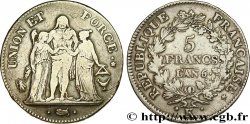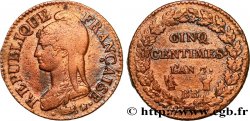v33_1509 - Cinq centimes Dupré, grand module 1799 Paris F.115/51
MONNAIES 33 (2007)
Starting price : 380.00 €
Estimate : 650.00 €
Realised price : 480.00 €
Number of bids : 3
Maximum bid : 501.00 €
Starting price : 380.00 €
Estimate : 650.00 €
Realised price : 480.00 €
Number of bids : 3
Maximum bid : 501.00 €
Type : Cinq centimes Dupré, grand module
Date: An 7/5 (1798-1799)
Mint name / Town : Paris
Quantity minted : ---
Metal : copper
Diameter : 28,23 mm
Orientation dies : 6 h.
Weight : 10,22 g.
Edge : chevronnée
Coments on the condition:
Exemplaire superbe et bien centré. Cette monnaie a été frappée avec des coins neufs comme en témoigne la présence de nombreux détails : le trait dans le creux de l’oreille au droit, les plis du drapé de l’artémis, la nervure centrale des feuilles du revers, les plumes de la queue du coq, les points sous les glands, le noeud parfait. On regrettera un petit coup sur le bonnet au droit. Jolie patine marron clair et des restes importants du rouge et du brillant d’origine, surtout au revers. Une des plus belles monnaies connues !
Catalogue references :
Predigree :
Cet exemplaire provient de la vente publique Poinsignon des 22 et 23 juin 1983 n° 941 et de la collection J.-P. Lebeau
Obverse
Obverse legend : .REPUBLIQUE - FRANÇAISE.*.
Obverse description : Buste drapé de la Liberté à gauche coiffée du bonnet phrygien (Mesdames Tallien ou Récamier) ; signé Dupré cursif au-dessous.
Reverse
Reverse legend : CINQ / CENTIMES..
Reverse description : En deux lignes dans le champ, au-dessus L’AN 7/5 suivi d'un point et de la lettre d'atelier A encadrés des différents, dans une couronne fermée composée de deux branches de chêne opposées nouées à leur base par un ruban.
Commentary
Corne d’abondance sous le coq. C’est le nouvel exemplaire de la Collection Idéale.








 Report a mistake
Report a mistake Print the page
Print the page Share my selection
Share my selection Ask a question
Ask a question Consign / sell
Consign / sell
 Full data
Full data









